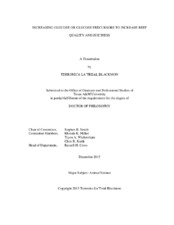| dc.description.abstract | We hypothesized that abomasal infusion of glucose, which would provide more glucose for absorption from the small intestine, would promote intramuscular (IM) adipose tissue development to a greater extent than ruminal infusion of acetate, propionate, or glucose. At 22 months of age, Angus crossbred steers (n = 24) were fitted with ruminal cannulas and adapted to a standard, corn/sorghum finishing diet over a 2-week period. Subsequently, the steers were infused with isocaloric amounts (3.76 Mcal/d) of glucose, propionate, or acetate. Glucose was infused either into the rumen or into the abomasum, whereas propionate and acetate were infused into the rumen.
Abomasal and ruminal infusion of glucose resulted in greater dry matter, organic matter, digestible energy, and gross energy intake than ruminal acetate infusion (P = 0.02). Infusate had no effect on quality grade or marbling score (P= 0.18), though acetate-infused steers had numerically greater marbling scores. The rate of glucose incorporation into fatty acids was greater in IM adipose tissue of acetate and propionate-infused steers than in abomasal or ruminal glucose-infused steers (P ≤ 0.02).
Steaks from the acetate, abomasal glucose-infused, and ruminal glucose-infused steers were higher in the flavor attributes brown/roasted, fat-like, and overall sweet, and lower in bitter basic taste, than steaks from the propionate-infused steers.
In a separate experiment, primals were taken from 4 USDA Select carcasses. Lean and fat trims were separated, and ground beef was formulated from each primal to contain 10, 20, or 30% total fat. Brisket patties contained higher proportions of monounsaturated fatty acids and less saturated fatty acids than flank patties. There were no differences in n−6 or n−3 fatty acids across primal type or fat level. After cooking, brisket patties had higher bloody/serumy and fat-like flavor aromatics than flank patties. Plate patties generated higher amounts of lipid-derived volatiles than patties from the brisket or flank.
In summary, abomasal infusion of glucose did not promote higher marbling scores, whereas propionate infusion promoted the greatest rates of fatty acid synthesis from glucose in IM adipose tissue. Additionally, individual primals can be used to formulate ground beef with unique compositional and flavor characteristics. | en |


